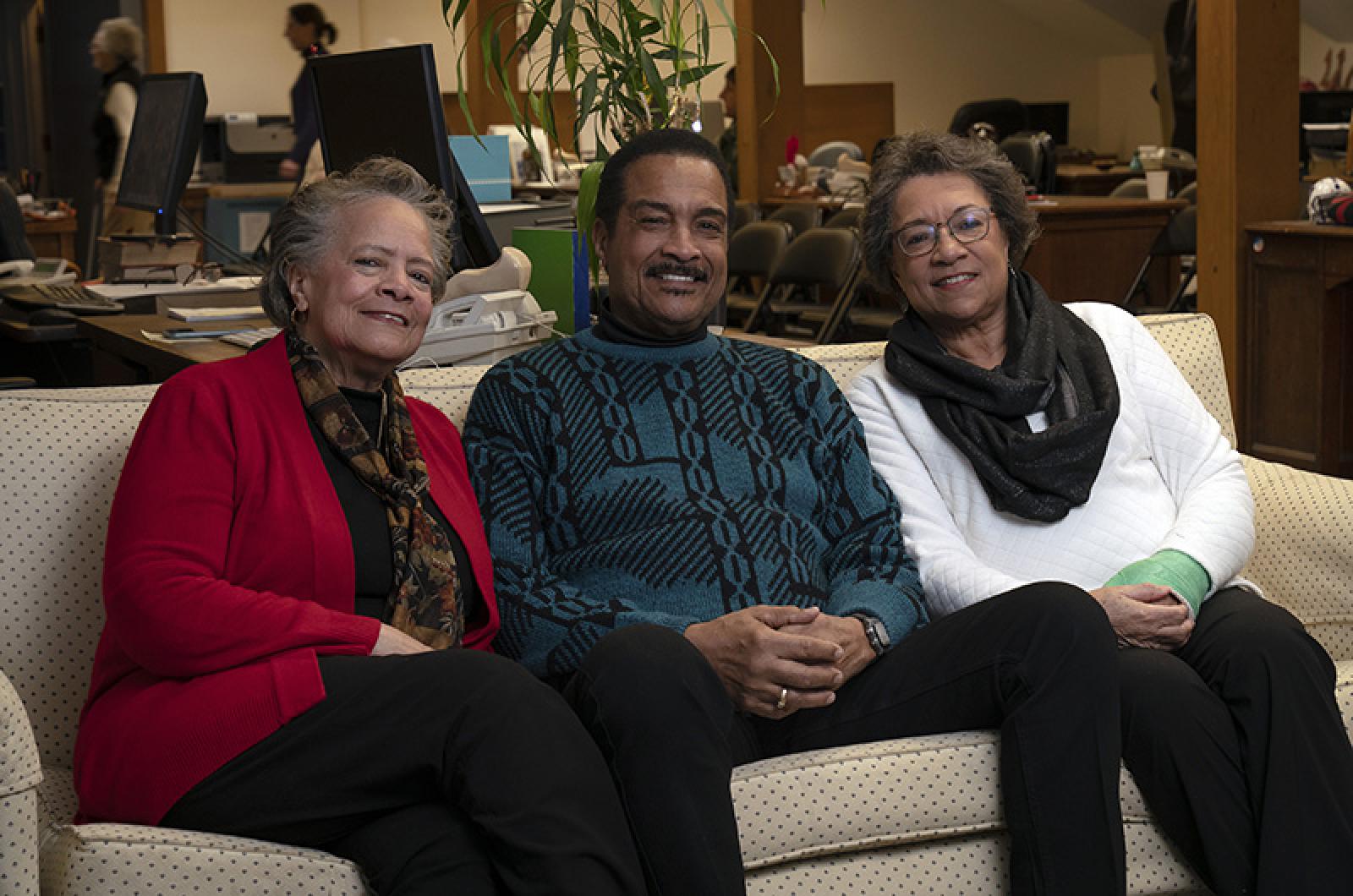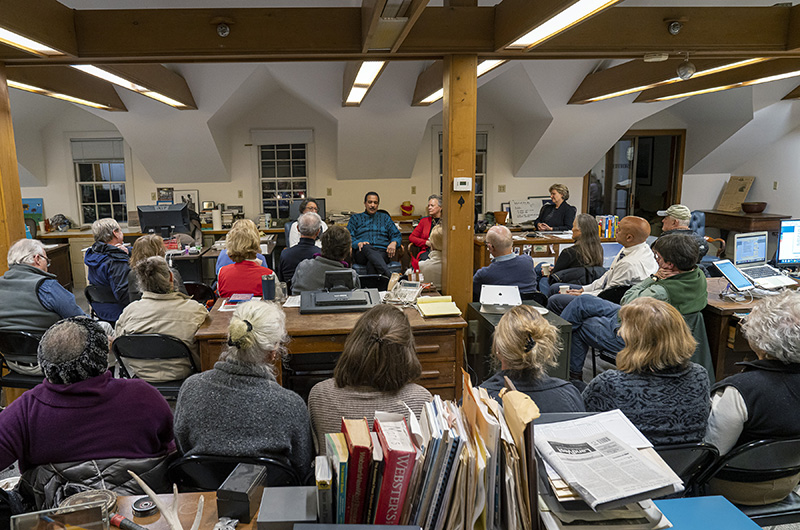When the doctor came to the house with his little black bag, five-year-old Pat Tankard knew just what (or rather, who) was inside.
“He’s got my brother in that bag!” Ms. Tankard recalled saying to herself.
And sure enough, she told an audience in the Vineyard Gazette newsroom Tuesday, “When he came down, we had a brother.”
That brother, Bob Tankard, also remembers the doctor arriving a few years later, to deliver his baby sister Carol. He, too, was sure she’d arrived in that little black bag.
All three Tankard siblings joined an eager audience of listeners for this month’s Tuesdays in the Newsroom talk, providing an Island take on Black History Month with stories from their African-American family’s life on Martha’s Vineyard.
Pat, Bob and Carol were among the 10 children—seven girls and three boys—of George and Audria Tankard, who in 1961 left a New Jersey housing project to settle their family on the Vineyard year-round. It was their mother’s idea, the siblings said, sparked in part by the 1957 Patti Page hit Old Cape Cod that inspired her to explore the Cape and Island on a pair of trips two years apart.
Carol Tankard Giosmas was eight years old when her mother took her to the Vineyard in the summer of 1959. “It was one of the most memorable times of my life,” she said.
But that summer visit didn’t prepare the Tankard kids for year-round life on Martha’s Vineyard.
“Two years later we move here, and I’m coming with the mindset of an eight-year-old—it’s going to be summer all the time and it’s going to be perfect,” Carol recalled. “I had made friends in the neighborhood, but they never said anything about winter.”
Bob, who was 13 when the family visited and 15 when they moved to Oak Bluffs, was even more perturbed by the change.
“The bramble bushes started running down the middle of the street at 5 o’clock on Labor Day,” he said. “I knew I was in trouble.”
Not only that, but his goal at the time was to be a professional baseball player and Martha’s Vineyard only had Little League, which Bob had long outgrown.
“Why did you bring me here?” the despairing teen asked his mother.
Before long, Bob found another direction for his athletic ambitions at Martha’s Vineyard Regional High School, which had opened in 1959 to replace the town high schools.
“When I went out for football, things changed,” said Bob, who in adulthood became the school’s head football coach and, later, principal of the West Tisbury School.
The Tankards discovered that racial prejudice, while still present on the Vineyard in the early 1960s, was much less blatant than where they had lived before.
“In New Jersey, you were either colored at the time or you were white or Hispanic,” Pat said.
On Martha’s Vineyard, the meaning behind skin color was more elusive. The Tankards met dark Cape Verdeans of African descent who considered themselves white, and light-skinned people with African-American features who identified as Wampanoag.
“When I should have been starting to date, there was a really small pool to choose from,” Carol said.
Racial presentation itself meant little to the Tankards, though, whose great-grandparents included the children of both slaves and slave-masters, Pat said. “We were never raised in a segregated neighborhood,” she said.
“We never felt inferior, because of our parents,” Carol added. “Our mom and dad were very adamant in teaching us that we are someone, that there is nobody else that is any better than you. You give respect and you demand respect in return. That was one of the things that all of us have always fallen back on throughout our lives.”
The Vineyard of the 1960s had other ideas.
“I had friends that I knew in school that lived in Edgartown. . . I couldn’t go to their houses, but they could come to mine,” Carol said. “It was because of my color.”
Still, it was an Edgartown girl who defended her by threatening to punch out a name-calling bully at the Boys and Girls Club. Carol recalled thinking, “This girl doesn’t even know me, but she’s willing to stand up for me.”
At the high school, Bob made friends he still calls brothers, including Tom Bennett, Joe Araujo, Tony daRosa and Doug Abdelnour.
“When I came up here and became friends with these guys, it was totally different,” he said. “The pressure and stress that I had felt in New Jersey, I didn’t feel here.”
At Inkwell beach in the summer, he also palled around with affluent African-American teens whose fathers were doctors, lawyers and businessmen—careers Bob hadn’t seen modeled by many men of color in his old neighborhood.
After high school, Bob joined the armed forces with some of his friends.
“Bob Tankard needed to grow up a little bit,” he said.
The horrors of war in Korea, particularly the suffering of children, left him determined to make a difference in the lives of young people at home.
“What am I going to do?” he recalled thinking. “I’m going to school. . . My goal was to give back to the community that had helped me to be successful.”
Pat and Carol also said their upbringing and Roman Catholic faith led them toward careers helping others.
“Our parents were strict when it came to morals and principles. . . I felt always that what I wanted to do was give back,” said Pat, who now works part-time in the parenting program at Martha’s Vineyard Community Services. “This is the joy of my life,” she said.
After running a taxi company with her husband George Giosmas, former proprietor of the Captain’s Table Diner in Oak Bluffs, Carol worked for nearly 20 years at Martha’s Vineyard Insurance before finishing her career as a substitute teacher at Edgartown School.
“It was extremely challenging, but it was one of the most rewarding jobs I have ever had,” she said.
Now retired, Bob still encounters former students who greet him with loving enthusiasm. His sisters hear about him regularly from fans in the community.
“A lot of people have said to me that my brother made a difference,” Pat said. “I think when you give of yourself and you give of your heart, that’s what happens.”
It all goes back to their parents, the siblings said.
“We were not wealthy people,” Pat said. “We had what everyone else had, pretty much. What they gave us was themselves.”








Comments (12)
Comments
Comment policy »